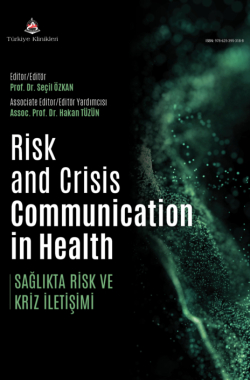Innovative Technologies for Health Crisis Communication
Mustafa ALTUNSOYa
aGazi University Sport Sciences Faculty, Ankara, Türkiye
Altunsoy M. Innovative technologies for health crisis communication. In: Özkan S, ed. Risk and Crisis Communication in Health. 1st ed. Ankara: Türkiye Klinikleri; 2024. p.91-7.
ABSTRACT
This chapter delves into the transformative role of innovative technologies in health crisis communication, examining how digital platforms, mobile health apps, AI, machine learning, and blockchain are reshaping public health responses. It highlights their application in disease tracking, information dissemination, and predictive analytics, alongside addressing ethical challenges like privacy and misinformation. Through case studies on COVID-19 and other health crises, the chapter showcases the effectiveness of these technologies in improving communication and management strategies. It concludes by envisioning future advancements and the importance of integrating these technologies into health crisis protocols, underscoring a future where technological innovation and public health are increasingly intertwined.
Keywords: Health crises communication; innovative technologies; AI and ML in health
Kaynak Göster
Referanslar
- Wang H, Cleary PD, Little J, Auffray C. Communicating in a public health crisis. Lancet Digit Health. 2020;2(10):e503. [Crossref] [PubMed]
- John Leon Singh H, Couch D, Yap K. Mobile Health Apps That Help With COVID-19 Management: Scoping Review. JMIR Nurs. 2020;3(1):e20596. [Crossref] [PubMed] [PMC]
- Attaran M. Blockchain technology in healthcare: Challenges and opportunities. International Journal of Healthcare Management. 2022;15(1): 70-83. [Crossref]
- Su Z, Zhang H, McDonnell D, Ahmad J, Cheshmehzangi A, Yuan C. Crisis communication strategies for health officials. Front Public Health. 2022;10:796572. [Crossref] [PubMed] [PMC]
- Donelle L, Comer L, Hiebert B, et al. Use of digital technologies for public health surveillance during the COVID-19 pandemic: A scoping review. Digit Health. 2023;9:20552076231173220. [Crossref] [PubMed] [PMC]
- Haddow GD, Haddow KS. Chapter Eleven - Communicating During a Public Health Crisis. In: Haddow GD, Haddow KS, eds. Disaster Communications in a Changing Media World. 2nd ed. Butterworth-Heinemann; 2014. p.195-209. [Crossref]
- Borges do Nascimento IJ, Pizarro AB, Almeida JM, et al. Infodemics and health misinformation: a systematic review of reviews. Bull World Health Organ. 2022;100(9):544-61. [Crossref] [PubMed] [PMC]
- WHO. Global strategy on digital health 2020-2025. Geneva: World Health Organization; 2021.
- Denecke K, Atique S. Chapter 4 - Social Media and Health Crisis Communication During Epidemics. In: Syed-Abdul S, Gabarron E, Lau AYS, eds. Participatory Health Through Social Media: Academic Press; 2016. p.42-66. [Crossref]
- Wong A, Ho S, Olusanya O, Antonini MV, Lyness D. The use of social media and online communications in times of pandemic COVID-19. Journal of the Intensive Care Society. 2020;22(3):255-60. [Crossref] [PubMed] [PMC]
- Al-Dmour H, Masa'deh R, Salman A, Abuhashesh M, Al-Dmour R. Influence of Social Media Platforms on Public Health Protection Against the COVID-19 Pandemic via the Mediating Effects of Public Health Awareness and Behavioral Changes: Integrated Model. J Med Internet Res. 2020;22(8):e19996. [Crossref] [PubMed] [PMC]
- Khan S, Vyawahare C, Singla K, Singh G. The Aarogya Setu mobile application as a bodyguard against COVID-19. J Family Med Prim Care. 2022;11(7):4115-6. [Crossref] [PubMed] [PMC]
- CDC. CDC Mobile App. 2018.(accessed March 10, 2024 2024). [Link]
- Reeves JJ, Ayers JW, Longhurst CA. Telehealth in the COVID-19 Era: A Balancing Act to Avoid Harm. J Med Internet Res. 2021;23(2):e24785. [Crossref] [PubMed] [PMC]
- Stieg C. How this Canadian start-up spotted coronavirus before everyone else knew about it. Mar 6, 2020 2020.(accessed Mar 10, 2024 2024). [Link]
- Elangovan D, Long CS, Bakrin FS, et al. The Use of Blockchain Technology in the Health Care Sector: Systematic Review. JMIR Med Inform. 2022;10(1):e17278. [Crossref] [PubMed] [PMC]
- Zhu P, Hu J, Zhang Y, Li X. Enhancing Traceability of Infectious Diseases: A Blockchain-Based Approach. Inf Process Manag. 2021;58(4):102570. [Crossref] [PubMed] [PMC]
- WHO. WHO Health Alert brings COVID-19 facts to billions via WhatsApp. April 26, 2021 2020.(accessed Mar 10, 2024 2024). [Link]
- Brownstein JS, Freifeld CC, Madoff LC. Digital disease detection--harnessing the Web for public health surveillance. N Engl J Med. 2009;360(21):2153-5, 7. [Crossref] [PubMed] [PMC]
- Kelvin AA, Banner D, Pamplona L, Alencar C, Rubino S, Heukelbach J. ZIKATracker: A mobile App for reporting cases of ZIKV worldwide. J Infect Dev Ctries. 2016;10(2):113-5. [Crossref] [PubMed]
- Quinn P. Crisis Communication in Public Health Emergencies: The Limits of 'Legal Control' and the Risks for Harmful Outcomes in a Digital Age. Life Sci Soc Policy. 2018;14(1):4. [Crossref] [PubMed] [PMC]
- Wang Y, McKee M, Torbica A, Stuckler D. Systematic Literature Review on the Spread of Health-related Misinformation on Social Media. Soc Sci Med. 2019;240:112552. [Crossref] [PubMed] [PMC]
- Argyres D, Hung A, Kennedy K, Pérez L, G. T. Digital health: An opportunity to advance health equity. July 26, 2022 2022.(accessed Mar 10, 2024 2024). [Link]
- Tsikala Vafea M, Atalla E, Georgakas J, et al. Emerging Technologies for Use in the Study, Diagnosis, and Treatment of Patients with COVID-19. Cell Mol Bioeng. 2020;13(4):249-57. [Crossref] [PubMed] [PMC]
- Arnaout A, Oseguera-Arasmou M, Mishra N, Liu BM, Bhattacharya A, Rhew DC. Leveraging technology in public-private partnerships: a model to address public health inequities. Front Health Serv. 2023;3:1187306. [Crossref] [PubMed] [PMC]
- Paulina B, Alejandra M-P, Loreto F-G, Angelina D. What is needed to effectively communicate risk during a health crisis? A qualitative study with international experts based on the COVID-19 pandemic. BMJ Open. 2023;13(5):e067531. [Crossref] [PubMed] [PMC]

